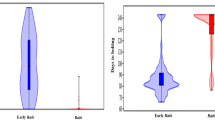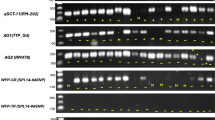Abstract
Till date only one sweet sorghum hybrid CSH 22SS has been released for general cultivation in India and the current levels of new hybrids are unable to surpass this hybrid. The objective of this study was to assess the general and specific combining abilities of eight parents and 16 hybrids respectively at three semi arid locations by following a line × tester mating design. Significant differences among environments, testers, environments × testers and environments × line × tester effects were observed for all traits suggesting the environmental influence on testers and the interactions. The variance component estimates of specific combining ability (SCA) were greater than that of general combining ability (GCA) for total biomass, juice extraction and grain yield indicating the non-additive control of genetic variation while the GCA variance was higher than the SCA variance for fresh stalk yield, juice yield, brix content, total sugar yield and computed bioethanol yields indicating additive gene action. Among females, DMS 28A for fresh stalk, juice and grain yields and DMS 25A for brix content were promising. Rio was a potential male parent for fresh stalk yield, total sugar content, computed bioethanol and grain yields. These parents can be exploited to address ethanol production from juice without compromising on grain yields. The best hybrids for total biomass, fresh stalk yield, juice yield, juice extraction, total sugar content and computed bioethanol yields were DMS 13A × Rio and DMS 23A × RS 647 and after adequate testing across many locations, these hybrids are recommended for commercial exploitation for ethanol production.

Similar content being viewed by others
References
Anonymous. 2004. ICRISAT to promote sweet sorghum for production of ethanol. Business Line; 2004 Aug 13; Sect. Industry and Economy.
Anonymous. 2011. Food and Agricultural Organization: FAO statistics database on the World Wide Web. Available at: http://apps.fao.org/default.jsp and http://faostat.fao.org. Last accessed on 9 Dec 2011.
Chapman, S.C., M. Cooper, D.G. Butler DG, and R.G. Henzell. 2000. Genotype by environment interactions affecting grain sorghum. I. Characteristics that confound interpretation of hybrid yield. Australian Journal of Agricultural Research 51: 197–207.
Corn, R. 2008. Sweet sorghum heterosis. Joint annual meeting, 5–9 October, Houston, TX, George R. Brown Convention Centre. Available online at http://a-c-s.confex.com/crops/2008am/webprogram/Paper42644.html. Last accessed on 1 December 2011.
Dayakar Rao, B., C.V. Ratnavathi, K. Karthikeyan, P.K. Biswas, S.S. Rao, Vijaya Kumar, and N. Seetharama. 2004. Sweet sorghum cane for biofuel production: A SWOT analysis in Indian context. NRCS—National Research Centre for Sorghum, Rajendranagar, Hyderabad 500 030, AP, India. Technical report no. 21.
Gururaj, H., N.R. Yekkeli, and B.Y. Kongawad. 2010. Sweet stalk sorghum: an alternative sugar crop for ethanol production. Sugar Tech 12(1): 79–80.
Haussmann, B.I.G., A.B. Obilana, P.O. Ayiecho, A. Blum, W. Schipprack, and H.H. Geiger. 1999. Quantitative-genetic parameters of sorghum [Sorghum bicolor (L.) Moench] grown in semi-arid areas of Kenya. Euphytica 105: 109–118.
Hays, H.K., I.R. Immer, and D.C. Smith. 1955. Heterosis in methods of Plant Breeding, 52–65. New York: Mcgraw-Hill Book Company Inc.
Indhubala, M., K. Ganesamurthy, and D. Punitha. 2010. Combining ability studies for quality traits in sweet sorghum (Sorghum bicolor (L.) Moench). Madras Agricultural Journal 97(1–3): 17–20.
Itai, M., T. Pangirayi, D. John, S. Julia, and F. Pedro. 2010. Combining ability and cultivar superiority of sorghum germplasm for grain yield across tropical low- and mid-altitude environments. Field Crops Research 116: 75–85.
Itai, M., T. Pangirayi, and John. Derera. 2009. Combining ability and heterosis of sorghum germplasm for stem sugar traits under off-season conditions in tropical lowland environments. Field Crops Research 114: 272–279.
Kempthorne, O. 1957. An introduction to genetical statistics. New York: Willey.
Kenga, R., S.O. Alabi, and S.C. Gupta. 2004. Combining ability studies in tropical sorghum [Sorghum bicolor (L.) Moench]. Field Crops Research 88: 251–260.
Mohammed, Maarouf I., and Moataz A. Mohamed. 2009. Evaluation of newly developed sweet sorghum (Sorghum bicolor) genotypes for some forage attributes. American-Eurasian Journal of Agricultural and Environmental Sciences 6(4): 434–440.
Marilia, C.F., T.C. Servio, O.R. Valter, V. Clibas, and T.M. Siu. 2001. Combining ability for nodulation in common bean (Phaseolus vulgaris L.) genotypes from Andean and Middle American gene pools. Euphytica 118: 265–270.
Mutengwa, C.S., P. Tongoona, S. Mabasa, and O.A. Chivinge. 1999. Resistance to Striga asiatica (L.) Kuntze in sorghum: Parent characterization and combining ability analysis. African Crop Science Journal 7: 321–326.
Panse, V.G., and P.V. Sakhatme. 1964. Statistical methods for agricultural workers, 2nd ed. New Delhi: ICAR.
Reddy, B.V.S., S. Ramesh, P. Sanjana Reddy, B. Ramaiah, P.M. Salimath, and Rajashekar. Kachapur. 2005. Sweet sorghum—A potential alternative raw material for bioethanol and bio-energy. International Sorghum and Millets Newsletter 46: 79–86.
Sankarapandian, R., J. Ramalingam, M.A. Pillai, and C. Vanniarajan. 1994. Heterosis and combining ability studies for juice yield related characteristics in sweet sorghum. Annals of Agricultural Research 15(2): 199–204.
Schaffert, R.E. 1992. Sweet sorghum substrate for industrial alcohol. In Utilization of sorghum and millets. Proceedings of the International workshop on policy, practice, and potential relating to uses of sorghum and millets; 1988 Feb 8–12; ICRISAT Center, Bulawayo, Zimbabwe, eds. Gomez, M.I., House, L.R., Rooney, L.W., Dendy, D.A.V., 131–137. International Crops Research Institute for the Semi-Arid Tropics.
Shukla, G.K., S.K. Gupta, S. Lakhendra, S.S. Rao, C.V. Ratnavathi, and B. Dayakar Rao. 2006. Successful pilot production of bio-ethanol from sweet sorghum in sub-tropical north India. Jowar Samachar 2(1): 1.
Singh, R.K., and B.D. Chaudhary. 1977. Biometrical methods in quantitative genetic analysis. Ludhiana: Kalyani Publishers.
Smith, G.A., and Buxton. 1993. Temperate zone sweet sorghum ethanol production potential. Bioresource Technology 43: 71–75.
Snedecor, G.W., and W.G. Cocharan. 1967. Statistical methods. New Delhi: Oxford IBH.
Srinivasa Rao, P., S.S. Rao, N. Seetharama, A.V. Umakanth, P. Sanjana, B.V.S. Reddy, and C.L.L. Gowda (eds). 2009. Sweet sorghum for biofuel and strategies for its improvement. ICRISAT information bulletin No. 77.
Tadesse, T., T. Tesso, and G. Ejeta. 2008. Combining ability of introduced sorghum parental lines for major morpho-agronomic traits. SAT eJournal 6: 1–7.
Tsuchihashi, N., and Y. Goto. 2004. Cultivation of sweet sorghum (Sorghum bicolor (L.) Moench) and determination of its harvest time to make use as the raw material for fermentation, practiced during rainy season in dry land Indonesia. Plant Production Science 7: 442–448.
Woods, J. 2000. Integrating sweet sorghum and sugarcane for bioenergy: Modeling the potential of electricity and ethanol production in SE Zimbabwe. Ph.D. Thesis. Kings College London.
Yu, J., and M.R. Tuinstra. 2001. Genetic analysis of seedling growth under cold temperature stress in grain sorghum. Crop Science 41: 1438–1443.
Acknowledgments
Authors are grateful to the Indian Council of Agricultural Research for financial support and the staff at Rahuri and Coimbatore locations for their assistance in running the sweet sorghum trials.
Author information
Authors and Affiliations
Corresponding author
Rights and permissions
About this article
Cite this article
Umakanth, A.V., Patil, J.V., Rani, C. et al. Combining Ability and Heterosis over Environments for Stalk and Sugar Related Traits in Sweet Sorghum (Sorghum bicolor (L.) Moench.). Sugar Tech 14, 237–246 (2012). https://doi.org/10.1007/s12355-012-0166-9
Received:
Accepted:
Published:
Issue Date:
DOI: https://doi.org/10.1007/s12355-012-0166-9




